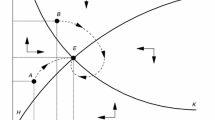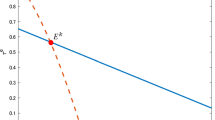Abstract
This paper constructs a small open two-sector (health care and non-health care) overlapping generations model and investigates how changes in the demand for health care induced by population aging influence the economy’s employment structure and per capita income growth rate. We show that population aging induces a shift in labor from the non-health care sector to the health care sector and lowers the per capita income growth rate. This paper also investigates public policy for child care and demonstrates the existence of an intergenerational conflict between current and future generations concerning public policy on child care.





Similar content being viewed by others
Notes
Source: The World Population Prospects: The 2004 Revision Population Database. The more developed regions include all countries in Europe plus North America, Australia, New Zealand, and Japan.
Source: OECD Health data 2006 and World Bank Development Indicators 2006.
The World Bank Development Indicators 2006 are used to calculate the old-age dependency ratio and the per capita output growth rate. We use data for 108 countries over the period 1975–2004.
This description of agents’ health care service demand is influenced by Bednarek and Pecchenino (2002), while they explicitly consider the aspect of health care service as “investment goods.”
Provided that agents demand health care in both youth and old age purely for consumption, the implications of the model remain mostly unchanged.
The relationship between the mortality rate at different ages and fertility remains poorly understood. Therefore, there is an ongoing empirical debate on this relationship. Contrary to Lorentzen et al. (2008), Acemoglu and Johnson (2006) find the positive effect of life expectancy on fertility. Moreover, Hazan and Zoabi (2006) provide theoretical insight into this question and show under which assumptions a standard model a là Barro–Becker yields each of the observed empirical cases.
Empirical work by Lorentzen et al. (2008) concludes that the impact of adult mortality on the investment in human capital is inconclusive. Therefore, this paper is partly consistent with their empirical results.
Because the level of \(A_{t}^{N}\) is irreversible, the relation \(G_{t}^{N} \ge 1\) holds. Thus, the incomplete specialization assumptions \(l_{t}^{H} \in (0,1)\) are summarized as the following parameter restrictions: \(l_{1}^{H}= \frac{(1-\gamma)R}{n_{0}}\frac{1+\phi+p}{1+p}\frac{V_{1}}{\bar{w}A_{1}h_{1}} \le 1\) and \(l^{H}(1,p)=\frac{(1-\gamma)R}{n_{t-1}(p)}\frac{p}{1+p} \le 1\).
See, e.g., Atoh and Akachi (2003).
Empirical studies by Winegarden and Bracy (1995) and Averett and Whittington (2001) conclude that the fertility effect of maternity leave is positive. On the other hand, Gauthier and Hatzius (1997) show that maternity leave has no significant effect on fertility, while family allowances have a positive and significant effect.
In the numerical simulation, we specify the production function of the non-health care sector as \(Y_{t}^{N}=K_{t}^{\alpha }(A_{t}^{N}L_{t}^{N})^{1-\alpha}\). In addition, the law of motion of the sector-specific labor productivity index \(A_{t}^{i}\) is given by \( A_{t+1}^{i}=[1+\beta^{i}(h_{t})^{\lambda ^{i}}(l_{t}^{N})^{\xi ^{i}}]A_{t}^{i}\). Then, in order to consider the case where the labor productivity growth rate of the non-health care sector is higher than that of the health care sector, we assume β N > β H. Rigorous explanations for the parameter values of our numerical simulation are available from the authors upon request.
References
Acemoglu D, Johnson S (2006) Disease and development: the effect of life expectancy on economic growth. NBER Working Paper, 12269
Atoh M, Akachi M (2003) Low fertility and family policy in Japan: in an international comparative perspective. J Popul Soc Secur Popul Stud 1:1–30 (Suppl)
Averett SL, Whittington LA (2001) Does maternity leave induce births? South Econ J 68(2):403–417
Becker GS (1965) A theory of the allocation of time. Econ J 75(299):493–517
Becker GS, Tomes N (1986) Human capital and the rise and fall of families. J Labor Econ 4(3):1–39
Bednarek HL, Pecchenino RA (2002) A macroeconomic analysis of publicly funded health care. J Public Econ Theory 4(2):243–270
Corrigan P, Glomm G, Mendez F (2005) AIDS crisis and growth. J Dev Econ 77(1):107–124
Gauthier AH, Hatzius J (1997) Family benefits and fertility: an econometric analysis. Popul Stud 51(3):295–306
Grossman M (2000) The human capital model. In: Culyer AJ, Newhouse JP (eds) Handbook of health economics 1A. North-Holland, Elsevier Science, Amsterdam, pp 347–408
Hazan M, Zoabi H (2006) Does longevity cause growth? A theoretical critique. J Econ Growth 11(4):363–376
Lagerlöf NP (2003) From malthus to modern growth: can epidemics explain the three regimes? Int Econ Rev 44(2):755–777
Lindh T, Malmberg B (1999) Age structure effects and growth in the OECD, 1950–1990. J Popul Econ 12(3):431–449
Lorentzen P, MacMillan P, Wacziarg R (2008) Death and development. J Econ Growth 13(2):81–124
Maclean D (1997) Lagging productivity growth in the service sector: mismeasurement, mismanagement of misinformation? Bank of Canada Working Paper, 97-6
Mankiw N, Romer D, Weil D (1992) A contribution to the empirics of economic growth. Q J Econ 107(2):407–437
McDonald S, Roberts J (2006) AIDS and economic growth: a human capital approach. J Dev Econ 80(1):228–250
Mountford A (1997) Can a brain drain be good for growth in the source economy? J Dev Econ 53(2):287–303
Newhouse JP (1992) Medical care costs: how much welfare loss? J Econ Perspect 6(3):3–21
Sanso M, Aisa RM (2006) Endogenous longevity, biological deterioration and economic growth. J Health Econ 25(3):555–578
van Zon A, Muysken J (2001) Health and endogenous growth. J Health Econ 20(2):169–185
Winegarden CR, Bracy PM (1995) Demographic consequences of maternal-leave programs in industrial countries: evidence from fixed-effects models. South Econ J 61(4):1020–1035
World Bank (1993) Investing in health: world development report 1993. Oxford University Press, Oxford
Acknowledgements
We wish to thank two anonymous referees, Noritsugu Nakanishi, Yoshiyasu Ono, Koji Shimomura, and participants of IEFS Japan Conference 2005 held at Kobe University for helpful comments and suggestions. All remaining errors are our own. We also acknowledge the financial support from the Ministry of Education, Culture, Sports, Science and Technology of Japan under the Grant-in-Aid for Young Scientists (B): (No. 20730132) and (No. 20730217).
Author information
Authors and Affiliations
Corresponding author
Additional information
Responsible editor: Junsen Zhang
Appendix
Appendix
The derivation of \(l_{t}^{H}\)
By substituting Eq. 3, \(w_{t}=\bar{w}A_{t}^{N}\), h t = h into Eq. 22, we obtain
In addition, by substituting Eqs. 7, 10, and 21 and h t = h into L t = h t η t N t , we obtain
Moreover, from substituting Eqs. 7, 10, and 21 into Eq. 19, we have
Using N t = n t − 1(θ)N t − 1, \(z_{t}=\frac{(1-\gamma)R}{1+\phi+p} \frac{(1-\tau_{t-1})}{G_{t-1}^{N}}A_{t}^{H}h\), \(N_{t}h=\frac{1+\phi+p}{1+p- \frac{\theta}{1-\theta}\phi}L_{t}\), and \(\tau_{t}=\frac{\phi}{1+p}\frac{\theta }{1-\theta}\), Eq. 12 is written as
Here, it corresponds to Eq. 23 when θ > 0 and Eq. 15 when θ = 0.
Rights and permissions
About this article
Cite this article
Hashimoto, Ki., Tabata, K. Population aging, health care, and growth. J Popul Econ 23, 571–593 (2010). https://doi.org/10.1007/s00148-008-0216-5
Received:
Accepted:
Published:
Issue Date:
DOI: https://doi.org/10.1007/s00148-008-0216-5




